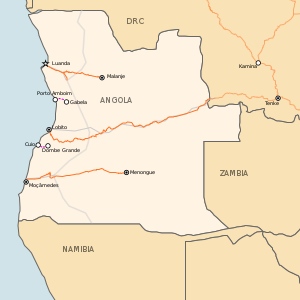Caminho de Ferro de Benguela
| Benguela Railway | |||
|---|---|---|---|

CFB Diesel locomotive, in 1973
|
|||
| Overview | |||
| Type | Heavy rail | ||
| Status | Operational | ||
| Locale | Angola | ||
| Termini |
Lobito Luau |
||
| Operation | |||
| Opened | 14 February 2015 | ||
| Technical | |||
| Line length | 1,344 km (835 mi) | ||
| Track gauge | 1,067 mm (3 ft 6 in) | ||
| Operating speed | 90 km/h (56 mph) | ||
| Highest elevation | 6,082 ft (1,854 m) | ||
|
|||
The Benguela railway (Portuguese: Caminho de Ferro de Benguela (CFB)) is a Cape gauge railway in Angola that connects the Atlantic port of Lobito to the eastern border town of Luau. At the border, it connects to a branch of the Katanga Railway, providing access to the Copperbelts of Congo and Zambia. The railway is named after the city of Benguela, which is connected by a branch line to the terminus of Lobito.
The railway is Cape gauge, 1,067 mm (3 ft 6 in), which is used by most mainline railways in southern Africa. The maximum design speed is 90 km per hour. The design capacity is 20 million tons of cargo and 4 million passengers per year. There are 67 stations and 42 bridges along the route of the railway.
The highest point on the railway is 6,082 feet.
The railway line roughly follows old trade routes between the ancient trading centre of Benguela and its hinterland of the Bié plateau. In 1899, the Portuguese government initiated the construction of the railway to give access to the central Angolan plateau and the mineral wealth of the then Congo Free State. A concession, running for 99 years, was granted to Sir Robert Williams on 28 November 1902. His Benguela Railway Company took over the construction which commenced on 1 March 1903. Messrs Pauling & Co. and Messrs Griffiths & Co were contracted to build sections of the railway. By 1914 when World War I started, 500 kilometres (310 mi) had been completed. Construction was halted until 1920 after which the railway's connection to Luau at the border to the Belgian Congo was completed in 1929. The primary purpose was the export trade and the "domestic Angolan traffic would be of secondary importance."
...
Wikipedia

